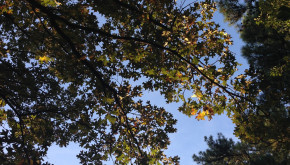
Fire plays a very important ecological role in forested ecosystems. Fires help maintain the forest by naturally thinning and pruning trees, and by reducing the buildup of surface fuels. Forest health is also benefited because fire helps to recycle nutrients, regenerate plants, and stimulate biological diversity among plant species and habitats.
Today, wildfire behavior is changing. The wildfire risk to life and property is greater than ever. This is due to an increase in the number of homes built in forests, and the introduction of human-caused ignition sources such as vehicles, equipment, fireworks, target shooting, outdoor burning, and recreational fires. This coupled with the current climate trend for warmer and drier conditions creates high probability for the incidence of a large scale, devastating fire.
While you can’t eliminate wildfire threat, you can increase your home’s chance of survival if a fire does occur. Oxygen, heat, and fuel are the three ingredients needed for fire to occur. In the forest, oxygen is present in the air. The heat could be the result of lightning or human activity. The final ingredient, fuel, is anything that burns including wood, plants, and structures. Fuels are also the only ingredient required by fire that you, the landowner, can influence and manage, so the key to reducing your home’s vulnerability to fire damage is reducing the buildup of surrounding fuels. The fewer and more spread out the fuels are, the slower the fire will spread.
Research suggests that focusing on the home’s immediate surroundings is the most effective way to improve it’s survivability. The zone closest to your home is called your defensible space. Your defensible space should extend a minimum of 30 feet from each of the edges of your home. This is the area that separates a house from an approaching wildfire. If vegetation is properly modified and maintained in your defensible space, a wildfire’s speed, flame length, and heat can be reduced which decreases the opportunity for ignition and helps firefighters to defend the home. Sometimes a defensible space is simply a properly-maintained yard.
Defensible spaces work best when they are kept lean, clean, and green.
Create a lean defensible space by decreasing the horizontal continuity between trees and shrubs. The best way to accomplish this is to create a wide spacing between individual trees and small groupings of shrubs. This will decrease the speed a fire will move across your property by decreasing the fuels available. Do not purge the area of all vegetation! While bare ground is certainly effective in reducing wildfire threat, it causes other problems like poor appearance, soil erosion, and other detrimental environmental effects. When given a choice, leave the largest trees because they are the most fire resistant. Broadleaved tree species are also good to keep because they have higher moisture contents and less flammable resins than conifers. Reduce the vertical separation between vegetation layers by removing ladder fuels and pruning your trees to 10ft off of the ground. Remove tree branches that are within 5 feet of your home.
Keep your defensible space clean by reducing the amount of dead plant material around your home, such as dead leaves, dry vegetation, down woody debris, flammable mulches, and even stacked firewood. Maintained lawns, groundcovers, perennials, and annuals that are properly organized in your defensible space can decrease the buildup of dead plant material. If your lawn browns, mow it down to two inches high. Prune dead branches off of shrubs and trees. This will help to reduce ladder fuels, too.
Keep your defensible space green by removing dead and dying plants and replacing them with native Firewise plants which will stay green all year long. These plants are adapted to the local environment and tend to contain more moisture in their tissues. While no plant is fire proof, the more moisture a plant contains, the more resistant it is to fire. Consider removing highly flammable plants that contain a large amount of oils and waxes. Some examples of these plants are ornamental junipers, holly, ivy, and young pine.
Help firefighters help you by posting a permanent, noncombustible sign prominently displaying your house number along the road. This will help firefighters find your home. If you have a gate, place it 30 feet off the road and install it to open inward. This way the truck can pull off of the road to unlock the gate without having to reverse. If possible, install a rapid entry system, which will allow the fire department access to padlocked and electric gates with a master key. Contact your fire department to find out which brand they prefer to use. Make sure your driveway and other roads on your property are well-maintained. This can be done by trimming the vegetation on the edges of your roads and removing down logs. Emergency vehicles need a clearance of 12 feet across the road and 15 feet high, as well as a turnaround with a radius of 45 feet. Firefighters are more effective with a good road system that reaches all of your property and has at least two exit routes. Talk to your fire chief for help in creating an effective road system.
For more examples of Firewise construction and landscaping, visit www.firewise.org to take a virtual tour of a Firewise home.
This blog post is excerpted and adapted, with permission from WSU Extension, from a WSU Extension online teaching module entitled "Reducing Fire Risk to Your Western Washington Home," By Lauren Grand, Forestry Program Coordinator, Washington State University Extension

